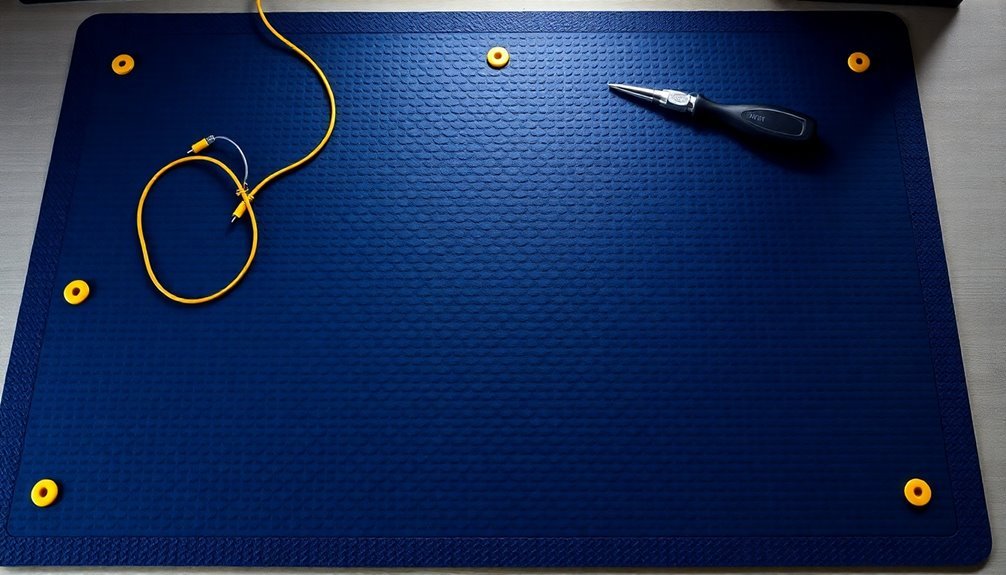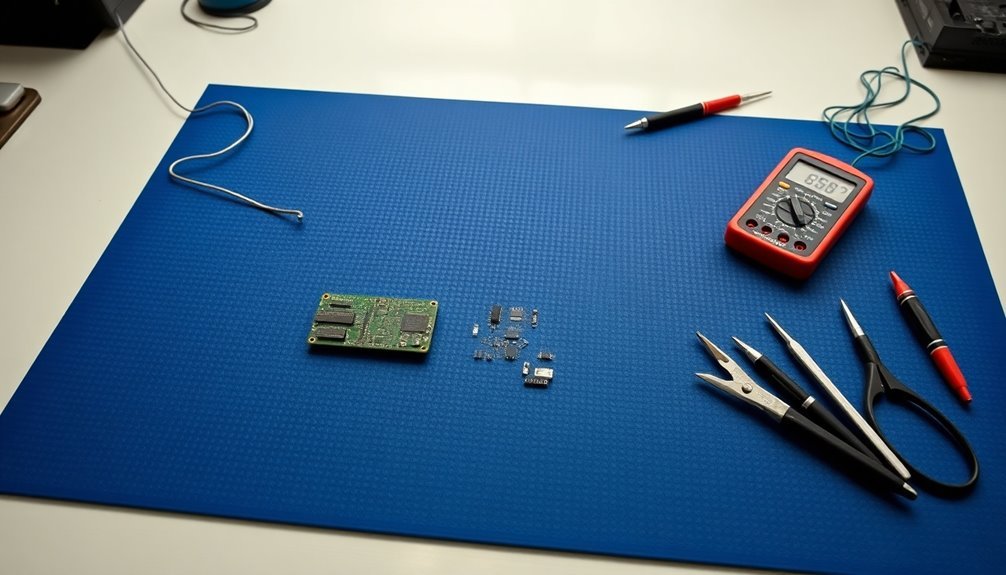You’ll find top-rated ESD-safe work mats offering professional-grade protection for your sensitive electronics in 2025. Leading options include the HPFIX ESD mat with complete grounding accessories, the Anti-Static Mat for PC repairs, and the versatile CPB S180 Silicone kit. These mats feature heat resistance up to 932°F, durable construction, and reliable static dissipation properties between 10^6 and 10^9 ohms. Premium choices like the iFixit Portable and SainSmart models provide additional organizational features and thorough ESD protection. Whether you’re soldering or repairing electronics, exploring these eight options will help you make an informed choice for your specific needs.
HPFIX ESD Safe Electronics Work Mat with Grounding Accessories

Electronics enthusiasts and repair professionals frequently choose the HPFIX ESD Safe Electronics Work Mat for its exceptional 932°F heat resistance and thorough static protection. The mat’s surface resistivity of 10^6 – 10^9 ohm effectively shields your sensitive components from static damage while providing a non-slip workspace measuring 20.7 x 13.4 inches.
You’ll find the included grounding accessories essential for safe repairs, featuring a grounding plug, cord, and wristband that work together to neutralize static risks. The mat’s organized layout with numbered cubicles and printed grid helps you keep track of tiny components during complex repairs. While you’ll need to clean it regularly due to dust attraction, maintenance is straightforward with mild cleaning solutions. HPFIX backs their product with a 180-day refund policy and lifetime warranty, ensuring you’re covered if any issues arise.
Best For: Electronics repair professionals, hobbyists, and technicians who need a heat-resistant, static-safe workspace for handling sensitive electronic components and soldering tasks.
Pros:
- Excellent heat resistance (932°F) makes it ideal for soldering work while protecting work surfaces
- Comprehensive ESD protection with included grounding accessories and appropriate surface resistivity
- Well-organized layout with numbered cubicles and measurement grid for keeping track of small parts
Cons:
- Requires regular cleaning due to dust attraction
- Working area (20.5 x 10.6 inches) may be too small for larger repair projects
- Some users report concerns about long-term durability and ESD properties maintenance
Anti Static Mat for PC ESD Mat (Soldering & Electronics Repair)
Professional repair technicians and DIY enthusiasts will find the Anti Static Mat‘s dual-layer protection essential for safeguarding sensitive electronic components. The 17×25-inch workspace features a blue dissipative layer that absorbs static and a black conductive layer that channels it safely away from your electronics.
You’ll appreciate the mat’s surface resistivity of 10^6 – 10^8 ohms and its ability to handle temperatures from -30℉ to 180℉, making it suitable for soldering tasks. While it’s effective for PC repairs, circuit board work, and cellphone maintenance, you should note some limitations. The mat tends to curl at the edges, so you’ll need to secure it with tape or weights for ideal performance. If you’re planning frequent use, consider that it’s not highly puncture-resistant, and you might want to invest in a more durable option.
Best For: Electronics repair professionals and DIY enthusiasts who need a dedicated static-protection workspace for PC repair, circuit board work, and soldering projects.
Pros:
- Dual-layer protection with static-dissipative and conductive layers provides comprehensive ESD protection
- Large 17×25-inch workspace accommodates various electronics repair projects
- Wide operating temperature range (-30℉ to 180℉) makes it suitable for soldering tasks
Cons:
- Edges tend to curl and require taping or weighing down for stable use
- Not highly durable against punctures and heat damage with regular use
- May not be suitable for portable or temporary workspace setups
Anti-Static Soldering Mat with ESD Safe Work Surface (23.6 x 13.8)
Whether you’re a DIY enthusiast or repair technician, this premium anti-static soldering mat provides essential ESD protection for your sensitive electronics projects. The mat features a resistivity value of 10^6 – 10^8 ohms and comes with essential ESD accessories, including a wrist strap and ground cords for complete device safety.
You’ll appreciate the generous 23.5 x 13.7-inch workspace that accommodates larger devices like laptops and multiple components. The premium silicone material withstands temperatures up to 932°F (500°C), protecting your workbench while resisting corrosion. It’s incredibly versatile, suitable for various electronics repair tasks, from smartphones to circuit boards.
This mat’s practical design allows for easy maintenance – simply clean with soap and water or alcohol. You can fold it without leaving creases, making storage hassle-free when you’re done working.
Best For: Professional electronics technicians, hobbyists, and DIY enthusiasts who regularly work with sensitive electronic components and need reliable ESD protection.
Pros:
- Comprehensive ESD protection with included accessories (wrist strap and ground cords)
- Generous workspace size and high heat resistance up to 932°F
- Easy to clean and store with crease-free folding capability
Cons:
- May be larger than needed for basic electronics projects
- Requires proper grounding setup to be fully effective
- Premium price point compared to basic work mats
HPFIX Heat Resistant ESD Mat with Grounding Tools
Soldering enthusiasts and repair technicians seeking superior heat protection will find the HPFIX Heat Resistant ESD Mat an essential addition to their workspace. The mat’s impressive 932°F heat resistance safeguards your desk from soldering iron damage while maintaining effective static protection with its 10^6 to 10^8 ohms surface resistivity.
You’ll appreciate the practical 15.9″ x 12″ workspace featuring 37 organizational slots and a built-in ruler for keeping small components sorted. The included grounding tools – plug, cord, and ESD wristband – guarantee proper static discharge protection for your sensitive electronics work.
While you might notice an initial odor that dissipates with time, and the grounding wires could be longer, the mat’s durability under intense soldering conditions makes it a reliable choice for electronics repair and assembly projects.
Best For: Electronics repair technicians, hobbyists, and DIY enthusiasts who need a heat-resistant workspace with ESD protection for soldering and assembly projects.
Pros:
- Outstanding heat resistance up to 932°F, protecting work surfaces from soldering iron damage
- Comprehensive organization system with 37 slots and built-in ruler for component management
- Complete ESD protection kit including grounding plug, cord, and wristband
Cons:
- Initial chemical odor requires time to dissipate
- Short grounding wire length may limit positioning flexibility
- May require regular cleaning to prevent residue buildup
Htm-203 Magnetic Repair Work Mat for Electronics and Computer Repair

Repair technicians and DIY enthusiasts will appreciate the Htm-203 Magnetic Repair Work Mat‘s extensive organization system. With 129 screw positions, 5 magnetic parts areas, and 12 component sections, you’ll keep every tiny piece exactly where you need it during repairs. The generous 22 x 14-inch silicone surface provides ample workspace for larger projects.
You’ll find this mat exceptionally durable, with heat resistance up to 932°F and protection against weak acids and bases. The built-in scale ruler helps you measure components precisely, while magnetic corners prevent screws from rolling away. Despite some user concerns about dark-colored parts being less visible on the black surface, the mat’s 4.7-star rating from nearly 1,800 reviews confirms its reliability. For electronics, computer repairs, or RC projects, you’ll benefit from its easy-to-clean surface and extensive organization features.
Best For: Electronic repair technicians, computer builders, and DIY enthusiasts who need a well-organized, heat-resistant workspace for managing small components during repairs or assembly.
Pros:
- Extensive organization system with 129 screw positions and multiple magnetic areas for secure component storage
- Exceptional heat resistance up to 932°F and chemical resistance to weak acids and bases
- Large 22 x 14-inch workspace with built-in ruler and easy-to-clean surface
Cons:
- Black surface can make it difficult to see dark-colored components
- At 1.88 pounds, it’s relatively heavy for portable use
- Higher price point compared to basic repair mats
CPB S180 Silicone Soldering Mat Kit with ESD Strap
Electronics enthusiasts and professional repair technicians will appreciate the CPB S180’s extensive workspace solution. At 21.6 x 13.8 inches, this silicone mat provides ample space for complex repair projects while incorporating practical features like 124 screw positions and three magnetic areas to prevent parts from getting lost.
You’ll find the mat’s heat resistance up to 932°F particularly useful for soldering tasks, while its built-in scale ruler and 18 notches help you organize components efficiently. The included anti-static wrist strap and three tweezers enhance your repair toolkit, making it suitable for both smartphone repairs and workshop applications.
While the mat’s surface might attract pet hair, its non-toxic, anti-slip design and thorough organization system make it a reliable choice for your electronics workstation. When you need to track tiny components during repairs, the magnetic sections and screw positions prove invaluable.
Best For: Electronics hobbyists, repair technicians, and DIY enthusiasts who need an organized, heat-resistant workspace for soldering and device repairs.
Pros:
- Large workspace with comprehensive organization features including magnetic areas and 124 screw positions
- Heat-resistant up to 932°F and comes with useful accessories (ESD strap and tweezers)
- Built-in ruler and anti-slip design enhance precision and safety during repairs
Cons:
- Surface tends to attract and collect pet hair
- Size may be too large for limited workspaces
- Magnetic areas might interfere with sensitive electronic components
iFixit Portable Anti-Static Mat with ESD Protection

If you’re a technician who needs to work on the go or a student in computer science classes, the iFixit Portable Anti-Static Mat offers essential ESD protection in a foldable design. The mat’s textured surface, similar to inflatable rafts, keeps your components from sliding while you work, and its branded quality sets it apart from generic alternatives.
You’ll find both the wrist strap and grounding mat strap rated at 1 million ohms, providing reliable static protection. While the mat’s portability is a major plus, you’ll need to purchase banana jack adapters separately for proper grounding. The surface doesn’t lay completely flat after unfolding, which might frustrate some users working on permanent setups. Despite these drawbacks, you’ll appreciate its functionality for temporary workspaces, though you’ll want to find your own storage solution as it doesn’t include a protective bag.
Best For: Computer science students, traveling technicians, and IT professionals who need portable ESD protection for electronics repair and maintenance work.
Pros:
- High-quality branded construction with reliable 1M ohm rating for both wrist and ground straps
- Portable and foldable design makes it easy to transport between work locations
- Textured surface provides good grip and prevents components from sliding during work
Cons:
- Banana jack adapters for grounding must be purchased separately
- Mat doesn’t lay completely flat after being folded
- Lacks included storage solution or protective carrying bag
SainSmart Heat Resistant Silicone Soldering Mat with ESD Protection
Workshop enthusiasts seeking a versatile soldering solution will appreciate the SainSmart Heat Resistant Silicone Soldering Mat‘s extensive feature set. At 20 x 14 inches, this mat offers ample workspace while withstanding temperatures up to 932°F (500℃).
You’ll find thoughtful organizational features including built-in rulers, 36 cubby notches, and 78 numbered screw positions that help track components during repairs. The mat’s premium silicone construction provides anti-skid and scratch-resistant properties, while magnetic sections prevent parts from rolling away. It’s particularly useful for electronics repairs, jewelry making, and gunsmithing projects.
While the included ESD wrist strap adds protection for electronic work, some users note the mat may be static resistant rather than fully ESD safe. The mat’s durability and easy-to-clean surface make it practical for regular use, though some find the flip-top covers unnecessary.
Best For: Electronics hobbyists, repair technicians, and DIY enthusiasts who need a well-organized, heat-resistant workspace for soldering and small component assembly projects.
Pros:
- Large 20×14 inch workspace with extensive organizational features including numbered screw positions, compartments, and built-in rulers
- Premium silicone construction offers excellent heat resistance up to 932°F and anti-skid properties
- Easy to clean, durable material with magnetic sections to prevent parts from rolling away
Cons:
- Flip-top compartment covers may be cumbersome and unnecessary for some users
- Questions about true ESD safety capabilities despite included wrist strap
- Some compartments and organizational features may not be practical for all types of projects
Factors to Consider When Choosing ESD-Safe Work Mats

When you’re selecting an ESD-safe work mat, you’ll need to evaluate several critical features to guarantee it meets your specific requirements. Your primary considerations should include the mat’s surface resistivity range for proper static dissipation, heat resistance for soldering tasks, and the overall size that fits your workspace. You’ll also want to check whether necessary grounding accessories are included and examine the material quality to guarantee long-term durability.
Surface Resistivity Range
A critical consideration in selecting ESD-safe work mats is their surface resistivity range, which typically spans from 10^6 to 10^9 ohms. You’ll want to choose a mat with resistivity that matches your specific needs – if you’re working with highly sensitive electronics that require quick static dissipation, opt for mats closer to 10^6 ohms. For less sensitive applications, mats with resistivity closer to 10^9 ohms will suffice.
In professional electronics assembly and repair environments, you’ll find that mats with resistivity between 10^6 and 10^8 ohms offer the ideal balance of protection and performance. Remember that your mat’s effectiveness isn’t solely dependent on its resistivity – you’ll need to use proper grounding accessories, including wrist straps and grounding cords, to maintain complete ESD protection.
Keep in mind that environmental conditions can affect your mat’s resistivity performance. Factors like humidity and temperature fluctuations may impact the mat’s ability to maintain consistent resistivity levels over time. You’ll need to regularly check your mat’s performance and verify it’s maintaining the appropriate resistivity range for your specific application.
Heat Resistance Capabilities
Temperature tolerance levels play an essential role in selecting your ESD-safe work mat, with resistance capabilities ranging from 180°F (82°C) to 932°F (500°C). When you’re working with soldering irons and other high-temperature tools, you’ll need a mat that can withstand intense heat without compromising its protective properties or damaging your work surface.
Look for mats made with silicone materials if you’re planning to perform frequent high-temperature tasks. These materials offer superior heat insulation and can protect against direct contact with soldering irons. Multi-layer mats that combine a dissipative top layer with a conductive bottom layer provide thorough protection while maintaining excellent heat resistance properties.
You’ll want to reflect on the longevity of your mat‘s heat-resistant features, especially if you’re working in high-temperature environments regularly. Extended exposure to extreme heat can affect the mat’s performance over time. Choose a mat that’s rated for temperatures well above your typical working requirements to guarantee lasting protection. If you’re frequently working with very hot equipment, opt for mats rated up to 932°F to ensure maximum protection and durability.
Size and Work Area
Beyond heat resistance specifications, selecting the right size for your ESD-safe work mat directly impacts your productivity and workflow efficiency. Common sizes range from 17 x 25 inches to 23.6 x 13.8 inches, but you’ll need to evaluate your specific project requirements to choose the most suitable dimensions.
For ideal workspace organization, consider mats with larger working areas, such as 20.7 x 13.4 inches or 22 x 14 inches. These dimensions provide ample space for your tools and components while reducing clutter during assembly or repair tasks. You’ll also want to factor in the mat’s thickness – aim for around 0.5 inches to guarantee durability and prevent edge curling over time.
Look for mats with built-in organizational features like dividers, compartments, or magnetic areas. These features help you keep track of small components and maintain an efficient workflow during complex repairs. Before making your final decision, measure your designated workspace carefully. Your chosen mat shouldn’t interfere with other equipment or tools you regularly use. Remember that a properly sized mat won’t just protect your electronics – it’ll also enhance your overall work efficiency and organization.
Grounding Accessories Included
Proper grounding accessories serve as essential components when choosing an ESD-safe work mat. You’ll want to verify your mat comes with thorough grounding solutions, including wrist straps, grounding cords, and compatible plugs. These accessories create a reliable pathway for static electricity to dissipate safely, protecting your sensitive electronic components during maintenance and assembly tasks.
When selecting your mat, confirm that it maintains a surface resistivity between 10^6 and 10^9 ohms, which you can only achieve through proper grounding connections. The included accessories should help you establish and maintain this ideal resistance range. You’ll need to connect both yourself and your work surface to the same electrical potential, which prevents unexpected static discharge that could damage your devices.
Look for mats that offer integrated grounding solutions, as they’ll provide you with everything needed to start working safely right away. These complete packages eliminate the need to purchase additional components separately and guarantee compatibility between all grounding elements. You’ll save time and money while maintaining consistent ESD protection throughout your workspace.
Material Quality and Durability
When selecting an ESD-safe work mat, material quality and durability stand as essential factors that directly impact its performance and longevity. You’ll want to make sure your mat maintains proper surface resistivity between 10^6 and 10^9 ohms to effectively protect against static discharge.
Look for mats made from premium silicone, which can withstand temperatures up to 932°F (500°C), making them ideal for soldering and other heat-intensive tasks. The best mats feature a multi-layer construction that combines dissipative and conductive layers, providing both superior static control and enhanced resistance to daily wear and tear.
You’ll need to take into account the mat’s resistance to physical damage, as punctures and abrasions can compromise its static-dissipative properties. Choose materials that won’t easily deteriorate under regular use. Additionally, opt for mats made from non-toxic, anti-corrosive materials, as they’re easier to maintain with routine cleaning – an essential aspect of preserving the mat’s effectiveness. Regular maintenance will help make certain your mat continues to provide reliable static protection throughout its service life, making your investment worthwhile in the long run.
Frequently Asked Questions
How Long Does the ESD Protection on a Work Mat Typically Last?
Your ESD mat’s protection typically lasts 2-3 years with proper care, but you’ll need to replace it sooner if you notice visible wear, loss of conductivity, or discoloration. Regular cleaning helps extend its lifespan.
Can ESD Mats Be Cleaned With Regular Household Cleaning Products?
You shouldn’t use regular household cleaners on ESD mats as they’ll damage the protective properties. Instead, use specialized ESD mat cleaners or a mild solution of water and isopropyl alcohol for safe cleaning.
Do ESD Mats Work Effectively in High-Humidity Environments?
Yes, ESD mats actually work better in high-humidity environments. You’ll get improved conductivity since moisture helps dissipate static charges more effectively. However, you shouldn’t let your mat get wet or become saturated with moisture.
What’s the Minimum Resistance Needed for an ESD Mat to Be Effective?
You’ll need an ESD mat with resistance between 1×10^6 to 1×10^9 ohms to effectively dissipate static charges. Anything below this range won’t protect components, while higher resistance won’t conduct charges properly.
Can Multiple People Safely Share One Grounding Point on an ESD Mat?
You shouldn’t share a grounding point with others. Each person needs their own separate connection to the mat to guarantee proper static discharge. Sharing can create inconsistent grounding and potential safety risks.
In Summary
You’ll find that investing in a high-quality ESD-safe work mat is vital for protecting your sensitive electronics. Whether you’re a professional technician or hobbyist, these mats offer essential static protection and heat resistance. Consider your workspace size, grounding requirements, and additional features like component organization when making your choice. Don’t compromise on quality – your expensive electronics deserve proper protection from static discharge.





Leave a Reply